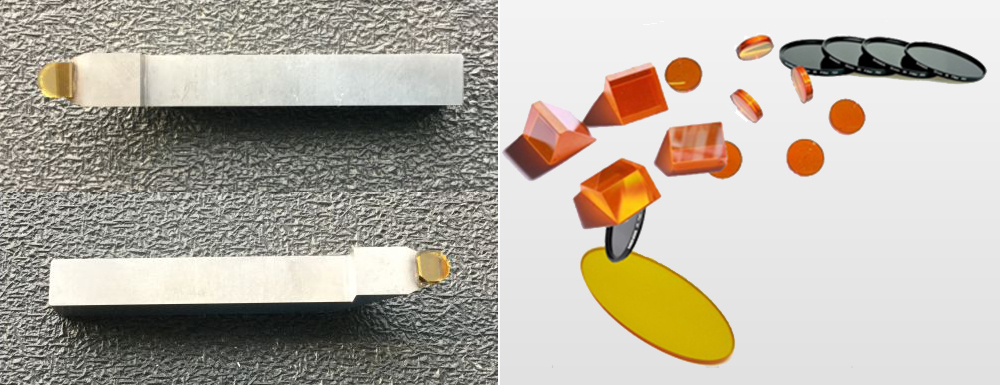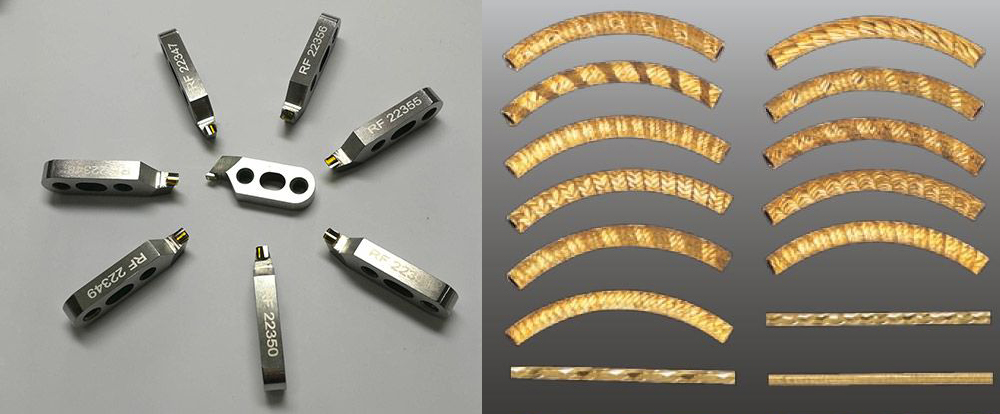Single crystal diamond tool
In ultra-precision machining,the main factors to ensure the quality of the machined surface are high-quality tools,in addition to high-precision machine tools and ultra-stable machining environments.Single crystal diamond has high hardness,good wear resistance,high strength,good thermal conductivity,low friction coefficient with non-ferrous metals,good anti-adhesiveness,excellent corrosion resistance and chemical stability, and can sharpen extremely sharp edges.It is considered to be the most ideal tool material for ultra-precision cutting, and has an important position in the field of machining,especially in the field of ultra-precision machining.
In the late 1970s,in the research of laser nuclear fusion technology,it was necessary to process a large number of high-precision soft metal mirrors,which required the surface roughness and shape accuracy of soft metals to reach ultra-precision levels. If the traditional grinding and polishing methods are used,not only the processing time is long,the cost is high, the operation is difficult,and the required precision is not easily achieved.Therefore,there is an urgent need to develop new processing methods. Driven by real-world demand, single-crystal diamond ultra-precision cutting technology has been rapidly developed.Due to the physical properties of single crystal diamond,it is not easy to stick to the knife and produce built-up edge when cutting. The surface quality is good. When processing non-ferrous metals, the surface roughness can reach Rz0.1~0.05μm.Single crystal diamond tools can also effectively process non-ferrous metal materials and optical materials, such as gold, silver, copper, aluminum and other non-ferrous metals and sapphire,zinc selenide,zinc sulfide,silicon,Ge,calcium fluoride,barium fluoride,Optical materials such as optical glass and ceramic crystals.

In ultra-precision machining,the two basic accuracies of a single crystal diamond tool are the accuracy of the blade profile and the blunt radius of the cutting edge.It is required that the roundness of the arc cutting edge for machining an aspherical lens is 0.05 μm or less,and the straightness of the cutting edge for machining a polyhedral mirror is 0.02 & mu; m; the blunt radius of the cutting edge of the tool (ρ value) is expressed The sharpness of the cutting edge of the tool,in order to adapt to various processing requirements,the blade edge radius ranges from 20nm to 1μm.
Diamond crystals belong to a planar cubic system. Due to the difference in atomic arrangement and atomic density on each crystal plane and the difference in the distance between crystal planes,the anisotropy of natural diamond crystals is caused. The performance is different,the manufacturing difficulty and the service life are different, and the microscopic damage strength of each crystal face is also significantly different.The microscopic strength of diamond crystals can be determined by the Hertz test method. Since diamond is a typical brittle material, its strength value generally deviates greatly, mainly depending on the shape and distribution range of the stress distribution,so it is suitable for analysis by probability theory.When the applied stress is the same, the (110) crystal plane has the highest damage probability, the (111) crystal plane is the second, and the (100) crystal plane has the smallest probability of damage. That is, under the action of external force, the (110) crystal plane is most likely to be broken,the (111) crystal plane is second, and (100) is the most difficult to break. Although the grinding rate of the (110) crystal plane is higher than that of the (100) crystal plane, the experimental results show that the (100) crystal plane has higher resistance to stress, corrosion and thermal degradation than other crystal planes. Combined with the micro-strength comprehensive consideration,using the (100) surface as the front and back knives of the tool makes it easy to sharpen the high-quality cutting edge and is less prone to micro-cracking.
The crystal face selection of single crystal diamond tools should normally be selected according to the requirements of the tool. In general,if the diamond tool is required to obtain the highest strength,the (100) crystal face should be selected as the front and back face of the tool;if the diamond tool is required to resist mechanical wear,the (110) crystal face is selected as the front and back of the tool.If the diamond tool is required to resist chemical wear,the (110) crystal face should be used as the rake face of the tool, the (100) crystal face should be used as the flank face, or the front and back facets should be (100) crystal faces.These requirements need to be achieved by means of crystal orientation technology.
Currently,there are three main methods for crystal orientation:artificial visual orientation,laser crystal orientation,and X-ray crystal orientation.
Manual visual inspection of crystal orientation: This method is based on the natural crystal geometry,surface growth,corrosion characteristics and geometrical relationship between the crystal faces,and the rough crystal orientation made by observation and experimentation by the operator's long-term work experience. The method is simple,easy,and does not require the use of equipment,but the accuracy of the orientation result is poor,the operator's experience is high, and the tool for processing and losing the characteristics of the natural single crystal crystal can no longer be manually determined.
Laser crystal orientation:laser crystal orientation is irradiated onto the surface of the diamond crystal with a laser with good coherence.The regular crystal lattice and microscopic pits formed during the growth process are reflected on the surface in different crystal directions.A characteristic diffracted light image is formed on the screen.However,in fact,due to external interference factors,the regular crystal lattice and microscopic pits formed naturally are not obvious or can not be observed at all.Therefore,the crystal is subjected to appropriate artificial etching before orientation to form a characteristic topography.
X-ray crystal orientation:Since the wavelength of the X-ray is close to the lattice constant of the crystal,diffraction occurs when the X-ray passes through or is reflected back from the crystal surface.A dedicated X-ray crystal orientation instrument has been developed using this principle. The crystal orientation method has high precision,but because X-rays have certain harm to the human body,it is necessary to pay attention to the protection of the operator when using.
The choice of the crystal orientation of the diamond tool:diamond anisotropy,so not only the hardness and wear resistance of each crystal face are different, but also the wear resistance of the same crystal face in different directions.If the crystal orientation is not properly selected, the sharpening efficiency will be greatly reduced even if the crystal face is selected correctly.At the same time, since the compressive strength of the diamond crystal is 5-7 times larger than the tensile strength,the easy-grinding direction of the crystal face should be selected during the sharpening process,and the cutting edge should face the positive direction of the sharpening wheel speed (ie,take Back grinding) to ensure sharpening efficiency and reduce the degree of microscopic cleavage of the cutting edge.
Grinding and damage of diamond cutters:The wear mechanism of diamond cutters is complex and can be divided into macroscopic wear and microscopic wear.The former is mainly mechanical wear and the latter is mainly based on thermal chemical wear. Common diamond tool wear and tear forms are flank wear, flank wear and edge cracking. In the single crystal diamond tool sharpening process, it needs to be worn to sharpen the tool that meets the requirements, but if the unnecessary wear is generated, the sharpened front and back flank surfaces may be damaged. The edge cracking (ie, chipping) occurs when the stress on the cutting edge exceeds the local bearing capacity of the diamond tool,and is generally caused by microscopic cleavage damage of the diamond crystal along the (111) crystal plane. In ultra-precision machining, the cutting edge of the diamond cutter has a relatively small radius, which is itself a hard and brittle material.At the same time,due to its anisotropy and the (111) surface is prone to cleavage,along with the vibration and the grinding wheel to the cutting edge the impact of the mouth is often accompanied by a chipping phenomenon.
Due to the requirements of the tool, or the shape of the diamond, it is sometimes necessary to divide the rough diamond. The diamond has parallel complete cleavage, and the carbon atoms in the diamond are combined with the carbon atoms by a covalent bond of a large force. However, in certain directions in the diamond structure, such as the application of a certain force in the direction of the parallel octahedron, the diamond is very susceptible to cracking, mainly because the diamond crystals have relatively few bonds connecting the faces. Therefore, the cleavage plane of the diamond is selected to divide the rough, and the method of splitting is shown in Fig. 1. A groove or nick called a slit is made on the diamond that needs to be split. The trick is to know where to sew and how deep you want to cut. In order to grind a high quality single crystal diamond tool, it is necessary to master the crystal orientation technology of single crystal diamond. This is mainly due to the anisotropic nature of the single crystal diamond, and the hardness of the diamond in various directions varies greatly. It is necessary to select the appropriate crystal face and crystal orientation as the rake face and the flank face of the tool, that is, the blade edge, so that the wear resistance and the processing performance are best. The interface of the diamond crystal is in the direction of good grinding, the grinding rate of the crystal face is the lowest, the crystal face is the second, and the grinding rate of the crystal face is the highest. Since the hardness of the crystal face is too high, the grinding process is difficult, and the microscopic strength is not high, and it is easy to be cleaved, and it is difficult to sharpen the sharp edge. The grinding surface is nearly twice as high as the crystal surface in the direction of good grinding, but the probability of damage from different crystal faces of diamond is applicable to various types of motors for comprehensive protection. For different motors, it is only necessary to adjust the corresponding threshold.





 简体中文
简体中文 English
English Pусский
Pусский
.jpg)